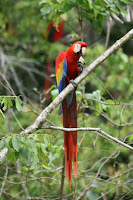Frog Song
"A bird doesn't sing because it has an answer, it sings because it has a song" – Maya Angelou
Heavy rain yesterday. This morning, a near-full moon muted behind thin clouds as if a lamp left on overnight. The temperature is mild; my tea barely steams out of its cup.
I once wrote in a poem: Every day breaks open like a geode or a kiwi fruit spilling its surprise. This morning the surprise that spills is the wild thrumming of spring peepers. The singing of what must be more than a hundred frogs excited along the creek below this ridge is literally unexpected music.
I can't think of any place I've lived—most recently Southwest Washington and before that Northcentral Pennsylvania and the Sierra foothills—where frogs sang at New Year's. In my teens and early 20s, I lived in the fertile Sacramento Valley, so perhaps frogs sang in early January there. But being young, I didn't know much about nature. I didn't know how to pay attention to what was around me, to use all of my senses to be fully in the world. Like many people, my head can be full of noise—too much thinking, fretting, giving away my attention to the chores and petty politics (small 'p') of being human.
Just now thick fog pools in the little valley, and like all those frog voices, lifts up through the ferns and redwoods. Sometimes it feels like the earth actually wants to touch me, to tell me something important. But for all I know, it's the three bedraggled ox-eye daisies relentlessly blooming in our winter garden that is the object of such attention and affection. Still, it could be me, right? Anyway, I keep waiting and listening.
The frogs are singing and singing. Of course, what I am calling a spring peeper is, in Northern California, a rain-loving tree frog.

Pacific Tree Frog Photo: Kelly McAllister & Washington Trails Assn.
http://www.wta.org/hiking-info/nature-on-trail/nature-on-trail-frogs
True spring peepers are an Eastern American and Canadian species, and their high-pitched voices do sound like chicks cheeping. I first became aware of spring peepers living in Williamsport, Pennsylvania, the birthplace of Little League, a place where March is very much a winter month.
There were three miracles that got me through seven March months in northern Pennsylvania:
- First came the emergence of the Eastern Skunk Cabbage blossoms, appearing long before the familiar big, rank leaves. The easily overlooked blossoms looked like waxy, purplish-red parrot beaks, each with a yellow ball in its mouth, odd flowers so determined to bloom that they burned through snow to appear.
- Next the Wood Thrushes arrived with their ethereal, flute-like calling, an unexpected exuberance in the bare maples.
- Then, spectacularly, the spring peepers filled every culvert, stream edge, and puddle of spring thaw with their ringing, bubbling music.
I heard—or noticed—the first Pacific tree frog on a rare, cold night a couple of weeks ago (26° is rare and cold for the North Coast). In a rush of night wind, the creak of a lone frog in the woods below reached me, among the creaking of redwood limbs above me. I thought, "You're singing to keep warm and sentient, aren't you?" I've read that these tiny frogs, typically smaller than a thumb and able to change color to blend with their environment, can partially freeze and then thaw back into life. Cold, then numb, then surprise, another chance to sing. Now I think, "people and frogs are no different." We all sing to keep warm and sentient, and, perhaps, just to hear our own song.
Join the Conversation: What surprised you today?


You certainly have a song! And some answers, too, I'll wager. Great read.
ReplyDeleteRob, thanks for commenting and your positive feedback.
ReplyDelete